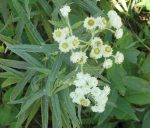 This herbaceous perennial is native to dry sandy soils in North America and parts of Asia, and is a member of the aster family (Asteraceae) that also includes daisy, yarrow, and lettuce. Growing up 1-3′ tall from a stoloniferous root system the plants have white woolly stems that are sometimes branched and become rust-colored as they mature. The linear gray-green leaves are 3-5″ long and have an abundance of woolly hairs on the underside. In late summer to fall flat flowerheads of small white flower with yellow centers appear in terminal clusters. Male and female flowers are on different plants and the pearly petal-like structures are actually bracts. Useful in borders, wildflower, prairie and meadow gardens. Dried flowerheads retain their whiteness so are especially valued to lighten up dried arrangements. This species is more drought tolerant than other Anaphalis bu may become invasive. The genus name, Anaphalis, is the classical Greek name for another everlasting plant. The specific epithet, margaritacea, is from the Latin word margarita, meaning pearl, and refers to the pearly appearance of the bracts of the flowers.
This herbaceous perennial is native to dry sandy soils in North America and parts of Asia, and is a member of the aster family (Asteraceae) that also includes daisy, yarrow, and lettuce. Growing up 1-3′ tall from a stoloniferous root system the plants have white woolly stems that are sometimes branched and become rust-colored as they mature. The linear gray-green leaves are 3-5″ long and have an abundance of woolly hairs on the underside. In late summer to fall flat flowerheads of small white flower with yellow centers appear in terminal clusters. Male and female flowers are on different plants and the pearly petal-like structures are actually bracts. Useful in borders, wildflower, prairie and meadow gardens. Dried flowerheads retain their whiteness so are especially valued to lighten up dried arrangements. This species is more drought tolerant than other Anaphalis bu may become invasive. The genus name, Anaphalis, is the classical Greek name for another everlasting plant. The specific epithet, margaritacea, is from the Latin word margarita, meaning pearl, and refers to the pearly appearance of the bracts of the flowers.
Type: Herbaceous perennial
Bloom: Terminal clusters of flat flowerheads of small white flower with yellow centers from late summer to fall
Size: 1-3′ H 1-2′ W
Light: Full sun to partial shade
Soil: Average, medium moist, well-drained; drought tolerant when established
Hardiness: Zones 3-8
Care: Low maintenance
Pests and Diseases: Chewing pests such as caterpillars
Propagation: Seed, division in early spring
Companion Plants: Purple cone flower, sedum ‘Autumn Joy’, black eyed susan, Liatris spicata
Photo Credit: Wikimedia